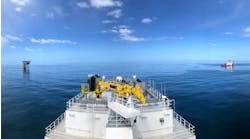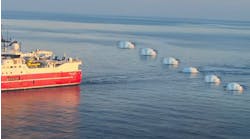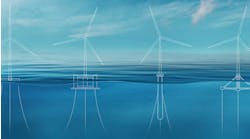Ronnie Burger, Tommy Grigsby, Savio Saldanha, Bart Waltman - Halliburton
Sand control plays a key role in production from the Gulf of Mexico (GoM). With some Lower Tertiary reservoir depths in excess of 30,000 ft (9,144 m), and reservoir interval lengths up to 1,500 ft (457 m), innovative completion methodologies must be devised to meet the challenges of the ultra deepwater sandface.
Sandface tool package
The long, deep reservoir intervals of the Lower Tertiary demonstrate the need to accomplish more tasks with fewer workstring trips.
Halliburton has developed its Enhanced Single-Trip Multizone (ESTMZ) system to allow fewer such trips while also providing the fit-for-purpose equipment to frac pack the Lower Tertiary. The system was developed to the specifications of a major deepwater operator. The system was qualified at a rate of 45 bbl per minute with a proppant volume of 400,000 lb of 16/30 HSP proppant for up to five intervals, providing a total proppant volume of 2 million pounds per well. In subsequent qualification testing, the tool system was qualified to a cumulative proppant volume of 750,000 pounds per interval for five intervals with a cumulative proppant volume of 3.75 million pounds proppant. A robust 4-in. OD inner workstring makes these high rates achievable. The large internal diameter reduces friction pressure so the stimulation treatment can be optimized for the formation, and helps to achieve maximum reverse out rate to ensure excess proppant is brought back to surface even with the use of large ID drillpipe. A 43/4-in. minimum ESTMZ system ID (sealbores) also makes a SmartWell completion inner zonal isolation string across the sandface feasible today.
A future advance may be to apply the ESTMZ system in an openhole environment. This initially could be a contingency in the event the casing string did not reach total well depth. Yet having to set a smaller liner may not be an economic option since it would severely inhibit the frac design and ultimately production. When used as a primary completion technique, the system would provide additional cost savings by helping eliminate the time and cost of installing casing across the completion interval, cementing, perforating, and cleaning and deburring the casing ID.
Reservoir stimulation
The Lower Tertiary formation can be described as having a permeability range of 10 md - 50 md and bottomhole reservoir pressures from 20,000 psi to 25,000 psi. As compared with deepwater Miocene reservoirs, a longer fracture length is required in this lower permeable formation to optimize production rates. As previously mentioned, these wells can have up to five pay intervals ranging in thickness from 100 ft (30 m) to over 300 ft (91 m). Fracturing such long intervals requires high pump rates. Because of the bottomhole pressures and potential high fracture gradients of these wells, the surface treating pressure can easily exceed the 15,000 psi working limits of conventional offshore pumping equipment and treating lines when using standard fracturing fluids.
While technically feasible, surface treating pressures above 15,000 psi may pose safety risks for service personnel on the vessel and rig. Such high pressure also could be a burst problem for the marine riser or casing below the subsea wellhead in the event of a shallow leak in the workstring without the benefit of sufficient hydrostatic support pressure.Halliburton’s solution to the challenges of treating formations with high bottomhole pressure is DeepQuest, a proprietary fluid that uses gravity to reduce the amount of surface treating pressure required to achieve adequate fracturing pressure to below 15,000 psi. The specific gravity for a conventional fracturing fluid is 1.00 to 1.04; while DeepQuest can have a specific gravity of 1.14 to 1.49 based on the well conditions.
This provides a 3,000 – 3,500 psi surface treating pressure reduction. In addition, the fluid does not require a specialized 20,000 psi stimulation vessel or treating lines. All of Halliburton’s stimulation vessels are fully capable of pumping the fluid which reduces the possibility of waiting on equipment. Twenty DeepQuest jobs have been pumped since 2004, with two of the treatments performed for a major operator in the Lower Tertiary formation.
Integration of uphole and sandface completions
The high cost of well intervention in ultra deepwater makes intelligent completions a logical choice, though most intelligent well completions also seek to increase ultimate reserve recovery. Commonly deployed intelligent completion technology allows for selective control of two main payzones (i.e., a stacked intelligent completion). Multiple zones with similar pressure regimes are required for commingling into either of these two main payzones. This limitation requires that reservoirs be segmented into long intervals, thus warranting an extended frac job or requiring additional wells to be drilled and completed to target the deeper higher pressured intervals.
One alternative is to run an inner SmartWell string inside the frac-packed interval to integrate the sandface with the uphole SmartWell completion assembly for a life-of-well solution to allow individual control over each interval. The downside of this is the flow restriction created by the inner SmartWell string in high-rate producer or injector wells. Incorporating downhole control of interval control valves with frac service tools requires some innovation. Bridging this technology gap will allow operators to optimize their returns on investment.




